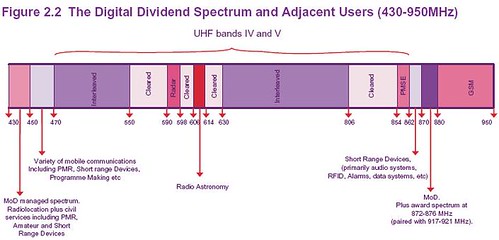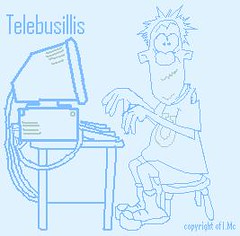Great News: Digital Dividend
You have to congratulate bureaucrats when they make the right decisions. When they make the right decisions on the biggest of issues, you can forgive loads and loads of relatively minor mistakes from the past. Well done, OFCOM on the publication of the Digital Dividend Review.
It is absolutely fantastic to hear the bureaucrats who go to print with statements like:
The “interleaved” spectrum is where DTT services will be broadcast: the BBC has 3 multiplexes and Commercial Television has another 3. Each of these multiplexes uses 8MHz (1 channel) of bandwidth which means that only 48MHz (6 channels) out of the 256MHz (32 channels) are in use at any one location.
The reason for the gaps if because in a high power broadcast transmitter setup there needs to be gaps in frequencies to avoid interference. However, low power transmitters are possible. Hence, a certain amount of interleaved spectrum is available at different frequencies in different areas of the country. OFCOM say the use of primary use of this could be to deliver local TV. However, I can think of plenty of low power uses within the home / office to build wireless networks.
There is also totally “Cleared” contiguous spectrum of 112MHz (14 channels) which can be used for TV, Mobile TV, Mobile Broadband or anything really. There are two channels which remain including the infamous Channel 36 which is currently only used by one company (BAE) for radar. The big appeal of this spectrum is that once cleared it can immediately be used to launch a nationwide network. In practice if the mobile operators bid on this and win a nationwide DVB-H mobileTV could be up and running by mid-2009. In the other spectrum launch of new services would have to be coordinated with the regional Digital Switch Off dates which will only be complete in 2012. Immediately it can be seen that Channel 36 is potentially the most valuable block of spectrum.
This is effectively the first stage with OFCOM publishing its approach. Effectively nothing is certain until the lobbying is over and the legislation is written which is planned for mid-2008. The uses of the spectrum will not be known until the end of auction which will be towards the end of 2008.
Interesting times ahead…
It is absolutely fantastic to hear the bureaucrats who go to print with statements like:
In short, it is not possible for us as the regulator to ‘know’ the best useThe long and short of it is that all the lobbying from the BBC and Channel 4 for free spectrum to deliver HD Television to the Middle to Upper Classes has come to nought. Similarly, the lobbying from the mobile operators for Channel 36 for DVB-H use has come to nought. Anybody can buy any spectrum if they bid enough at the auctions planned for late 2008.
...
Our analysis shows that if we pick preferred uses or users:
• we will distort incentives. The uses and users that get preferred access will have less incentive to use spectrum efficiently. They will tend to use too much, relative both to other potential users of the spectrum and their own use of other inputs to deliver services;
• we will reduce flexibility. If we pick a preferred use and user when we award the spectrum, we will have to impose extra constraints on the way the spectrum is used. There will be less flexibility for the way that spectrum is used to change if circumstances change – for example if demand for the preferred use turns out to be less than expected, or alternative uses turn out to be more valuable;
• we will risk distorting competition, because the preferred users may gain an advantage, and risk reducing the scope for innovation in uses that cannot get access to the spectrum; and
• we will risk getting it wrong, by picking a use or user that turns out not to be the best. This risk is larger the more uncertainty there is in the decision.
The “interleaved” spectrum is where DTT services will be broadcast: the BBC has 3 multiplexes and Commercial Television has another 3. Each of these multiplexes uses 8MHz (1 channel) of bandwidth which means that only 48MHz (6 channels) out of the 256MHz (32 channels) are in use at any one location.
The reason for the gaps if because in a high power broadcast transmitter setup there needs to be gaps in frequencies to avoid interference. However, low power transmitters are possible. Hence, a certain amount of interleaved spectrum is available at different frequencies in different areas of the country. OFCOM say the use of primary use of this could be to deliver local TV. However, I can think of plenty of low power uses within the home / office to build wireless networks.
There is also totally “Cleared” contiguous spectrum of 112MHz (14 channels) which can be used for TV, Mobile TV, Mobile Broadband or anything really. There are two channels which remain including the infamous Channel 36 which is currently only used by one company (BAE) for radar. The big appeal of this spectrum is that once cleared it can immediately be used to launch a nationwide network. In practice if the mobile operators bid on this and win a nationwide DVB-H mobileTV could be up and running by mid-2009. In the other spectrum launch of new services would have to be coordinated with the regional Digital Switch Off dates which will only be complete in 2012. Immediately it can be seen that Channel 36 is potentially the most valuable block of spectrum.
This is effectively the first stage with OFCOM publishing its approach. Effectively nothing is certain until the lobbying is over and the legislation is written which is planned for mid-2008. The uses of the spectrum will not be known until the end of auction which will be towards the end of 2008.
Interesting times ahead…





<< Home